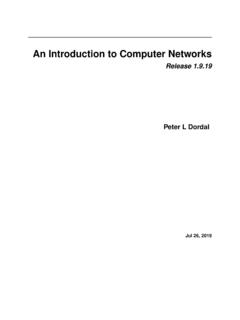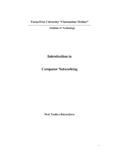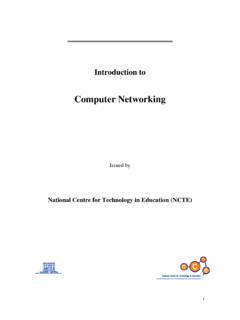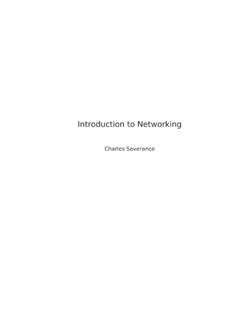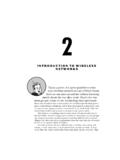Transcription of Introduction to Computer Networking Chapter 1
1 Chapter 1 1 Introduction to ComputerNetworkingChapter 1CH-1015 Jean-Yves Le BoudecICA, EPFLC hapter 1 This lecture requires that you buy a textbook on TCP/IP. The book Irecommend as the best complement to these notes is mentioned on the , there are many good books on TCP/IP: feel free to choose anotherone. 2oGoal of the introductionlunderstand TCP/IP and Networking terminology layered model transport protocol TCP; UDP; IP; MAC IP addresses, MAC addresses,machine names, DNS, NetBIOS names, port numbers routers, bridges, servers client server architecture HTTP, FTP, SMTP multiplexing protocol connectionlsimple transport layer: UDPlbasic elements of transmissionoTextbook[Stevens] TCP/IP illustrated volume I , The protocols, W. Richard Stevens, AddisonWesley (Very detailed, experimental hands-on description of TCP/IP. Also volume III forHTTP) Chapter 1In this lecture we study Computer use a top-down approach, starting with socket programming.
2 We will studyin this Chapter the global picture, which will enable you to get startedwith writing your first programs. Then in the following chapters, we willstudy the various components (called layers ), one by are Computer networks used for ? Computer networks allow people and machines to communicate, using a numberof services. The slide shows a small subset of services. 3 Network Servicesonetwork services examples:ldistributed database, Web (3) , file transfer, remote login,email,news, talk, remote processing, resource sharing (fileservers, printers, modems), network time, name service (2)..user clicks: addr = addr = (HTML page)123name serverWeb serverChapter 1A Computer network is made of two disctinct subsets of components- distributed applications are programs running on interconnected computers;a web server, a remote login server, an email exchanger are examples.
3 Thisis the visible part of what people call the Internet . In this lecture wewill study the simplest aspects of distributed applications. Moresophisticated aspects are the object of lectures called DistributedSystems and Information Systems .- the network infrastructure is the collection of systems which are requiredfor the interconnection of computers running the distributed is the main focus of this network infrastructure problem has itself two aspects:- distance: interconnect systems that are too far apart for a direct cableto be possible- meshing: interconnect systems together; even in the case of systemslocated close to each other, it is not possible in non-trivial cases to drawcables from all systems to all systems (combinatorial explosion, cable saladmanagement problems). The distance problem is solved by using a network, such as the telephonenetwork with modems (see later).
4 The meshing problem was originally solvedeasily because the terminals were not able to communicate with each other,but always has to go through a main Computer . The mesh in such cases isreduced to a star network. Today this is solved by a complex set of bridgesand routers. 4 Network InfrastructureA Computer network is made ofodistributed applicationslprovides service to userson other machines, or to other machineslis in computersonetwork infrastructure:lsupports transport of data between computers where distributed applications residelin computers (Ethernet card, modem + software)+ in special network devices (bridges, routers, concentrators, switches)focus of this lecture = network infrastructureChapter 1 The objective of this and the following slides is to introduce the conceptof layers. Like any complex Computer system, a network is decomposed intofunctions.
5 This decomposition is, to a large extend, stable: computernetworking people have agreed on a reasonable way to divide the set offunctions into what is called layers .The decomposition always assumes that the different components can beordered such that one component interfaces only with two adjacentcomponents. We call layers the start with the simplest, and oldest, network example: it is a mainframeconnected to terminals. In that case, there are mainly two functions physical layer: translates bits into electromagnetic waves; data link layer: translates packets into two functions are implemented on cables or on radio links. Thephysical layer has to do with signal processing and coding; it is the objectof the lecture called Telecommunication . The data link layer has to dowith bits and bytes; we will study the data link layer in this lecture.
6 5 Physical LayerData Link Layerpoint to pointcablesmainframecomputerterminals12T 1T2T3 to T3: Hello From T1: Hello ophysical transmission = Physical functionlbits <-> electrical / optical signalsltransmit individual bits over the cable:modulation, encodingopacket transmission = Data Link functionlbits <-> frameslbit error detectionlpacket boundarieslin some cases: error correction byretransmissionoModems, EthernetsChapter 1 Modern networks have more than physical and data link. The network layer isthe set of mechanisms that can be used to send packets from one Computer toanother in the world. There are two types of networks:With Packet switching, data packets can be carried together on the samelink. They are differentiated by addressing information. Packet switching isthe basis for all data networks today, including the Internet, public datanetworks such as Frame Relay or , and even Switching is the way telephone networks operate.
7 A circuit emulatesthe physical signals of a direct end-to-end cable. When computers areconnected by a circuit switched network, they establish a direct data linkover the circuit. This is used today for modem access to a data circuit switches are based on byte multiplexing and are thus similarto packet switches, with the main difference that they perform non-statistical multiplexing (see what this means later in this Chapter ).A network has Intermediate systems (ISs): those are systems that send datato next ISs or to the destination. Using interconnected ISs saves cable andbandwidth. Intermediate systems are known under various terms depending onthe context: routers (TCP/IP, AppleTalk,..), switches ( , Frame Relay,ATM, telephone), communication controllers (SNA), network nodes (APPN) 6A NetworkoNetwork layerl set of functions require to transport packets end-to- endlexamples: IP, Appletalk, IPXointermediate systemlforwards data not destined to itselfpacket switch14, 6aT1T2T3T42a1a3a5a 4a23srce=T2, dest=M2, to T3: hello M1M2 Chapter 1 Physical, data link and network layers are sufficient to build a packettransport system between computers.
8 However, this is not enough for you write a low-level program which uses the network (as we will do inthis lecture), you do not handle packets, but data. The primary goal of thetransport layer is to provide the programmer with an interface to , the transport layer uses the concept of port. A port is a numberwhich is used locally (on one machine) and identifies the source anddestination of the packet inside the machine. We will come back to theconcept of ports later in this transport layer exists in two varieties: unreliable and reliable. Theunreliable variety simply sends packets, and does not attempt to guaranteeany delivery. The reliable variety, in contrast, makes sure that data doesreach the destination, even if some packets may be lost from time to time. 7 Transport LayeroWhy a transport layer ?ltransport layer = makes network service available to programslis end-to-end only, not in routersoin TCP/IP there are two transport protocolslUDP (user datagram protocol) unreliable offers a datagram service to the application (unit of information is a message)lTCP (transmisssion control protocol) reliable offers a stream service (unit of information is a byte)oan application uses UDP or TCP, it is a designer s choiceluse for example the socket API: a library of C functionslsocket also means (IP address, port number) Chapter 1 8 Protocol, service and other fancy definitionsoPeer entitiesltwo (or more) instances of the same layeroProtocol and PDU.
9 Lthe rules of the game observed by peer entitieslthe data exchanged is called PDU (protocol data unit)lthere is one protocol (or more) at every layeroService and SDUlthe interface between a layer and the layer abovelthe interface data is called SDU (service data unit)oConnectionla protocol is connection oriented if the peer entity must be synchronized beforeexchanging useful data; otherwise it is protocol is the formal definition of external behaviour for communicatingentities. It defines:- message formats- expected actions (message sent, data delivered, abort)Examples of protocols are:TCPUDPIPE thernetProtocols are connection oriented or connectionless. A connection exists ifthe communication requires some synchronization of all involved partiesbefore communication can take place. The telephone system is connectionoriented: before A can send some information to B, A has to call B (or viceversa) and say hello.
10 The postal (mail) system is connectionless. If Awants to send some information to B, A can write a letter and mail it, evenif B is not ready to read functions are ordered in a layered model:- layer n communicates with other layer n entities using the layer nprotocol, the deat units exchanged are called layer n PDUs (protocol dataunits)- layer n uses the service of layer n-1 and offers a service to layer n+ entities at the same layer are said peer 1 Flow 2 illustrates the query/response protocol of the Domain Name System (DNS).The name resolver and the name server are two application programs, probably Cprograms using sockets. These programs use UDP, which is the non-reliabletransport protocol used in the us now apply the terminology on this example. name resolver uses the UDP service: it creates a request to send data to nameserver . name server is identified by its IP address (for ).


